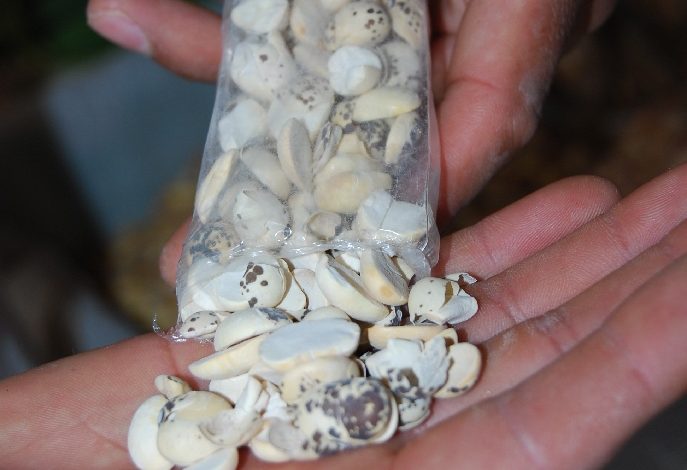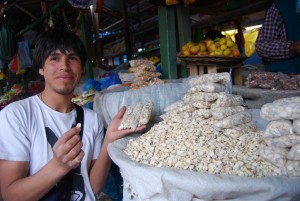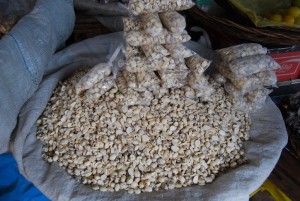Popped Beans and Explosive Struggle

They look like little pigeon eggs, but when tossed in the mouth they crunch into a puff of air and taste. Sold on many streets in Cuzco these are something uniquely Andean that have created a bit of a stir elsewhere as they raise a challenge to international notions of property, though here they are just a common snack. They are the popped beans, or toasted beans in Spanish, known by the Quechua word Ñuña, simplified into English as Nuna beans or Nuña beans.
Besides corn, and potatoes, Peru is the land of beans. From here comes that bean whose name in English is the same as the Peruvian capital, Lima beans, known as pallares in Peruvian Spanish. Each region, except for the high, cold valleys and plateaus, have their own varieties of beans, making frejoles or porotos (as they are called in Spanish) an important part of Peruvian gastronomy.
Among these the ñuña is unique. It grows in the cooler, higher valleys, and does not need long boiling. Instead when toasted, it pops.
Toasted grains are one of the varieties of indigenous food in the region around Cuzco where they alone can be key to a meal. Most tourists only encounter this technique of processing food in the toasted corn, canchitas, that is served as an appetizer in many restaurants. But if they look in the streets or shop at the markets they find a much wider range of toasted grains. Among them this bean.
In fact, these beans have been found in remains from 1100 years ago. They are an ancient Peruvian food.

If nothing else, the small plastic bags of porotos tostados (toasted beans) make a quick and protein filled snack. When walking around, or checking out Cuzco’s many sites of interest, it is good to have a bag in you pocket to provide you with that burst of energy to keep you going.

But they popping beans have also entered into international struggles. Toasting them dry or in some hot oil requires only some ten minutes, far less than is required to boil beans. As a result they are more energy efficient in these times of concern over the economy and scarcity of fuel.
As a result, Californians Jeffrey Ehlers and Mark Sterner became fascinated with their economic possibilities. But the beans had three problems from a commercial mind set: They grew on long, trailing vines, they produced continuously over the growing season, and they were very light sensitive, only flourishing where days were about twelve hours long.
Ehlers and Sterner crossed these beans with more ordinary beans that grew on bushes, produced a single crop, and were not so light sensitive. Wen they found the right combination that kept the popping and yet produced in ways that worked for large scale commercial agriculture, they sought patents. The United States granted them the patent as did the World International Property Organization.
Peruvians were outraged. How can Americans patent what is ours? How can individuals claim as their property what really belongs to all the farmers of the Peruvian and Bolivian valleys who for thousands of years have been growing these beans? How can they privatize what is a common good?
As a result, Peruvians have sought unsuccessfully to the moment, to have the patents overturned.

The controversy still rages and is part of diplomatic efforts as well as concerns by Peru to protect its cultural heritage, including its gastronomy. It is widely felt that UNESCO will soon declare Peruvian cuisine to be Patrimony of Mankind, and Peru is working to brand, legislate, and protect its richness.
But this is not just about Peru, the issue of cultural property versus private patents is a hot button that is exploding in many debates and social movements throughout the world.
Despite what happens elsewhere, the ñuña continues to be eaten in Cuzco. It is grown nearby in valleys where bean vines twine around towering cornstalks. Part of the cultural heritage as popping bean, and as an example of an important culinary technique, tostado de poroto is sold throughout the city. You can buy a bag and partake.




